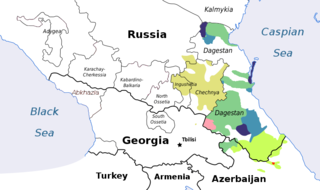Related Research Articles
Most languages of Europe belong to the Indo-European language family. Out of a total European population of 744 million as of 2018, some 94% are native speakers of an Indo-European language. Within Indo-European, the three largest phyla in Europe are Romance, Germanic, and Slavic; they have more than 200 million speakers each and together account for close to 90% of Europeans. Smaller phyla of Indo-European found in Europe include Hellenic, Baltic, Albanian, Celtic, and Armenian ; Indo-Aryan, though a large subfamily of Indo-European, has a relatively small number of speakers in Europe.

The Northeast Caucasian languages, also called East Caucasian, Nakh-Daghestani or Vainakh-Daghestani, is a family of languages spoken in the Russian republics of Dagestan, Chechnya and Ingushetia and in Northern Azerbaijan as well as in diaspora populations in Western Europe and the Middle East. They are occasionally called Caspian, as opposed to Pontic for the Northwest Caucasian languages.

Of all the languages of Russia, Russian, the most widely spoken language, is the only official language at the national level. There are 35 languages which are considered official languages in various regions of Russia, along with Russian. There are over 100 minority languages spoken in Russia today. From 2020, amendments to the Russian Constitution stipulate that Russian is the language of the "state forming people". With president Vladimir Putin’s signing of an executive order on 3 July 2020 to insert the amendments into the constitution, they took effect on 4 July 2020.
Godoberi is an Andic language of the Northeast Caucasian language family spoken by the Godoberi in southwestern Dagestan, Russia. It is spoken by approximately 130 people out of an ethnic population of 3,000. There are two dialects - Godoberi and Zibirhali, which differ mainly in pronunciation.
The Andic languages are a branch of the Northeast Caucasian language family. They are often grouped together with the Avar language and (formerly) with the Tsezic (Didoic) languages to form an Avar–Andic branch of that family.
Maninka, or more precisely Eastern Maninka, is the name of several closely related languages and dialects of the southeastern Manding subgroup of the Mande language family. It is the mother tongue of the Malinké people in Guinea, where it is spoken by 3,300,000 people and is the main language in the Upper Guinea region, and in Mali, where the closely related Bambara is a national language, as well as in Liberia, Senegal, Sierra Leone and Ivory Coast, where it has no official status. It was the language of court and government during the Mali Empire.

The official language of Greece is Greek, spoken by 99% of the population. In addition, a number of non-official, minority languages and some Greek dialects are spoken as well. The most common foreign languages learned by Greeks are English, German, French and Italian.
The Bartangi language is a Pamir language spoken along the Bartang River from Yemtz to Nikbist, in Gorno-Badakhshan Autonomous Region. It is typically classified as a dialect of Shughni, but is quite distinct. Within Bartangi, there are two (sub)dialects, Basid and Sipandzh, which are named after the villages in which they are spoken. It is not written.
Andi is a Northeast Caucasian language belonging to the Avar–Andic branch spoken by about 5,800 ethnic Andi (2010) in the Botlikh region of Dagestan. The language is spoken in the villages Andi, Gunkha, Gagatl, Ashali, Rikvani, Chanko, Zilo, and Kvanxidatl.
The Botlikh people are an Andi–Dido people of Dagestan. Until the 1930s they were considered a distinct people. Since that time they have been classified as Caucasian Avars and have faced a campaign to have them assimilate into that population. The Botlikh are primarily Sunni Muslims.
Botlikh or Botlix may refer to:

Sámi languages, in English also rendered as Sami and Saami, are a group of Uralic languages spoken by the Sámi people in Northern Europe. There are, depending on the nature and terms of division, ten or more Sami languages. Several spellings have been used for the Sámi languages, including Sámi, Sami, Saami, Saame, Sámic, Samic and Saamic, as well as the exonyms Lappish and Lappic. The last two, along with the term Lapp, are now often considered pejorative.

Botlikhsky District is an administrative and municipal district (raion), one of the forty-one in the Republic of Dagestan, Russia. It is located in the west of the republic. The area of the district is 500 square kilometers (190 sq mi). Its administrative center is the rural locality of Botlikh. As of the 2010 Census, the total population of the district was 54,322, with the population of Botlikh accounting for 22.4% of that number.
The Dagestan uprising of 1920–1921 was an event during the Russian Civil War.
Andi is a large village in the Botlikh region in Dagestan, Russia
Gunkha is a small village in Botlikh district in Dagestan, Russia
Ashali is a small village in Botlikh district in Dagestan, Russia
References
- ↑ Ethnologue language map of European Russia, with Botlikh shown in the inset with reference number 9
- 1 2 Botlikh at Ethnologue (18th ed., 2015) (subscription required)
